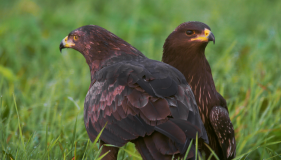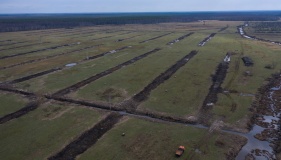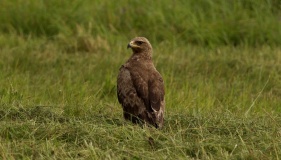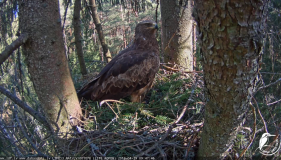Already for the second year inventory of Lesser spotted eagle nests is carried out in Latvia. It is a precondition for precise and reasonable species protection. Therefore the project "Conservation Arrangements for Lesser Spotted Eagle in Latvia" implemented by Latvian Fund for Nature carries out nest intventory in all territory of Latvia. This season has been very successful - the experts have found a record number of nest - 177. Last season 111 nests were discovered. Experts say - this has been a very good nesting year, young birds have been observed in much more nests than previously.
At the same time the observation made last year proves to be true – around 10% of the nests have been affected by forestry. For example, nests are found in a forest prepared for cutting, nest trees are not marked for conservation. Also there have been cases where forest is cut up until the nest and the eagle most probably will leave this nest forever.
Data about the nests have been submitted to State Forest service and Lesser spotted eagle experts will prepare proposals for microreserves. 108 microreserves have been proposed for nests found last year, 60 of them with total territory of 555 ha have been approved.
Microreserve is the best way to protect the large birds in the most precise manner and without creating unnecessary restrictions. However, the experience with formation of microreserves and the opinions voiced by the land owners clearly indicate that the current annual compensations available in Latvia are not enough. Therefore Latvian Fund for Nature calls to review the existing order and to improve the compensation system by adding one-off payments for the lost income.
To prepare for the next nesting season the project experts have planned to create 15 artificial nests. This is a well tested conservation method in territories where the natural nests have become unstable. The experience of previous years tells that Lesser spotted eagles gladly use the articial platforms.
Jānis Ķuze, the project leader:
This has been an excellent year in terms of the number of newly found nests, also the nesting results have been good. However, it is a second year in row when one tenth part of the nests that we have found have been affected by forestry. This is already a stable trend and it brings up again the question how we are protecting our values of nature connected with forests. I believe that in long term we will be able to protect the birds nesting in forests only if the motivate the private forest owners by introducing a fair compensation system.







